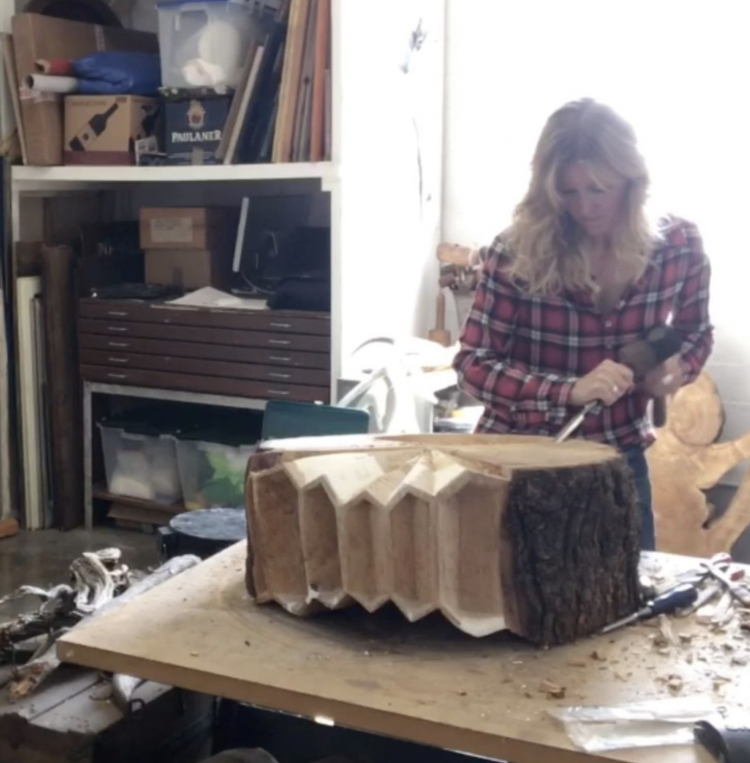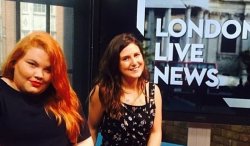- Jobs
- Open Calls
- Events
- Learning
- More
- SUBMIT
Rosebraugh and Water Crystals

Keri Rosebraugh
Artist Keri Rosebraugh creates visual representations showing how man and nature are connected. As she makes her art, she fearlessly raises questions about how we all are connected to each other.
KARDIA: Have you always been creating artwork throughout your life?
ROSEBRAUGH: I can remember drawing and coloring since I was very young - and I suppose around those years when adults start asking you the famous question, “What do you want to do when you grow up?” About the age of 10 is when I knew I wanted to become an artist. I guess I’ve had it easy in that way because I’ve seen a lot of people struggle for years trying to figure out what makes them happy in a career. Thankfully, I just always knew. For me, artwork has taken many twists and turns. I began as an editorial illustrator, which morphed into large scale murals and paintings. Then in the last 5 years I have concentrated more on sculptural pieces and installations.
K: Were there times that you were more creative than others? What do you think was the catalyst for more creativity in your life?
R: For me it comes from strong emotional responses to my surroundings. A feeling of awe while in the middle of nature, sadness and loss from a death of a close one, happiness when I’m in love, or anxiousness during a pandemic — these all have powerful energies that affect me. Creating artwork is how I respond to such intense emotions. In general I have always expressed myself more gesturally rather than verbally.
A Letter To My Sister, 2015 | Spitsbergen, Norway
K: As an artist, what is your greatest duty for your artwork and viewers?
R: I think if by creating a piece of art I can make a viewer think differently about something -- see something in a new way, or spark a new thought or idea even for a minute or two — then I am happy..
K: To date, you have established an incredible amount of work relating to the environment, human impact on nature, and the concept or relationship to the idea of home. Specifically, Lead Feet, highlights the different meanings of home. What does it mean to you?
R: Home is an interesting subject for me because I have moved locations over 30 times in my life. I believe now that my image of the ideal place, the right place, the one true home is not an actual location, but only brief moments in time when the clock no longer exists in one’s head.
K: When creating these “Home” structures what is your creative process like? Do you sketch before sculpting? How do you think spatially so fluently?
R: With the “Home” series, I specifically did not sketch my ideas beforehand. I gathered up all the materials (branches, sticks, dirt, metal, etc) and then just started building them organically from the bottom up. I wanted them to change shapes as I went because in real life, dwellings seem to get modified and altered over circumstances and time. The odd thing is that I ended up sketching some of them after they were created. I am not sure why.
K: What is the importance of using found materials for you? How does the actual site of the art and incorporating associated elements play into that process? Are there any installation artists that have influenced you to work with this process?
R: I use quite a bit of found objects in my work. Mostly I see and keep them with the idea of using them for some installation in the future. But a few I seek out with an idea already in mind. Nonetheless, conceptually the role they play is always quite specific and has meaning. So in this sense I do not use found materials randomly. The exact object or objects are chosen with the goal to drive the concept of each piece. I do like land artists as well as artists from the Arte Povera movement and artists who use natural materials such as Guiseppe Penoni, Joseph Beuys, Anslem Kiefer, Wolfgang Laib, and Beverly Pepper are a few.
K: Water. This series is fascinating. Did your residency in the Arctic region near Norway spark your interest in the conditions of water? How did you manage this investigation on the reactions of water to its surroundings?
R: I have always had a weird love/hate relationship with water. Growing up in Oregon, rain was a large part of my childhood and by the time I was eighteen I couldn’t wait to leave the damp, sometimes moldy wetness behind. Years later traveling to the high Arctic I was surrounded by the vast ocean in an old barquentine sailing boat for over two weeks. This is when I realized the power and importance that water has — we can’t live without it. Our bodies are 60-70% water. We are all connected and the way in which we treat water is in the long run the way we treat ourselves.
K: How did you carry out the process of viewing the molecular structure response of water to its surroundings? Did you have help with analyzing the water samples? Were you surprised by your findings?
R: The first time I froze water crystals I was attending an artist residency on the River Seine in France. I purchased a cheap microscope online and packed it in my suitcase along with a camera to attach to the viewfinder to video the crystals as they froze. I didn’t take into consideration that I needed a container to hold the dry ice underneath the slide which holds the water droplet. This residency was located in the countryside and there wasn’t very many options for resources, so I found a thrift store and bought a glass ashtray for a few dollars and converted that into the petri dish holding the dry ice. It was sort of comical at how primitive the set up was. That being said, I was floored and screamed out loud when I watched the first water crystal that showed signs of mimicking its surroundings as it froze. I was not expecting this result whatsoever.
K: How has your community in Los Angeles, California and Marnay Sur Seine, France, provided support in your creative experience? Did you choose these locations for a specific reason?
R: Los Angeles is where I went to college for my undergrad degree and I have work connections here, as well as my family. This is what drives me to return every winter — a strong sense of wanting to spend the holidays with my parents as well as keeping good relations with collectors, clients, and friends. Creatively, my passion lies in France. When I am at my studio in Marnay Sur Seine, I am closer to nature and have a community of artists who are aligned with my purpose and share similar ideas on art and life which lead to inspiring conversations and collaborations.
K: In what ways do you find inspiration outside of the studio? What makes you feel alive?
R: Nature and travel. Anywhere in nature that is quiet leads me to focus and take in all the found materials I have at my doorstep. Traveling to places I have never been opens a portal to new ideas and concepts that intrigue me. This opens my mind. I think the secret to inspiration is learning.
K: How can your communities best support you and your artwork?
R: I guess the best way for communities to support artists is by letting artists have a voice — which in turn lets us support the communities. I believe most artists create artwork which reflects their surroundings, their inner thoughts, and the way they see the world. If communities are open to supporting the arts, they actually are bringing us more together by sharing and honoring diverse views about the one world that we all live in.
Interview By:
|
TRAN NGUYEN
Illustrator |
DARREN J DOWNING
Illustrator |
Catherine & Rebecca
Founders of Solo Craft Fair |
EMMA COYLE
Fine Artist |








